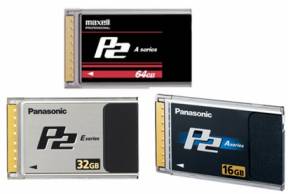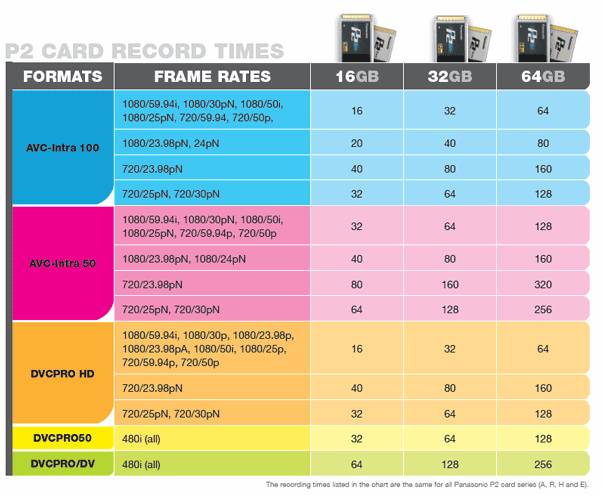
P2 (P2 is a short form for “Professional Plug-In”) is a professional digital recording solid-state memory storage media format introduced by Panasonic in 2004, and especially tailored to electronic news-gathering (ENG) applications. It features tapeless (non-linear) recording of DV, DVCPRO, DVCPRO25, DVCPRO50, DVCPRO-HD, or AVC-Intra streams on a solid-state flash memory. The P2 card is essentially a RAID of Secure Digital (SD) memory cards with an LSI controller tightly packaged in a die-cast PC Card (formerly PCMCIA) enclosure, so data transfer rate increases as memory capacity increases. The system includes cameras, decks as drop-in replacements for Videocassette recorders (VCR), and a special 5.25-inch computer drive for random-access integration with non-linear editing systems (NLE). The cards can also be used directly where a PC card (PCMCIA) slot is available, as in most older notebook computers, as a normal hard disk drive, although a custom software driver must first be loaded.
As of early 2010, P2 cards are available in capacities of 4, 8, 16, 32 and 64 GB. At introduction, P2 cards offered low recording capacity compared to competing, video tape-based formats (a miniDV tape holds roughly 13 GB of data, and an S-size HDCAM tape holds 50 GB). To solve this, camcorders and decks using P2 media employ multiple card slots, with the ability to span the recording over all slots. Cards are recorded in sequence, and when a card is full, it can be swapped out while another card is recording. This limits recording time only by power supply and the available number of cards. If a card is partially full, the deck will record only until it is full. Unlike video tape, old video cannot be recorded over accidentally; old footage must be manually deleted.

P2 cards are of a ruggedized PCMCIA type with the fastest transfer speeds currently available through this format. The card also contains a processor that organizes and safeguards the files and the case is developed and crafted to “military” (according to Panasonic) specifications, making P2 cards tough and reliable.
The first pieces of equipment released by Panasonic which use the P2 format included the AJ-SPX800 (a 2/3″ broadcast camcorder for ENG and EFP applications), the studio recorder AJ-SPD850, the AJ-PCD10 offload device (basically, a five-slot PC card reader with USB interface designed to fit a 5-1/4″ IT systems bay), and the memory cards themselves – AJ-P2C004 (4 GB) and AJ-P2C002 (2 GB). Panasonic is currently shipping a wide range of camcorders that support the P2 format, including the professional video camera AG-HVX200 HD handheld camcorder, and the high-end, or broadcast professional shoulder-mount AG-HPX500, AJ-HPX2000, and AJ-HPX3000 camcorders. Panasonic has also announced the P2-based AG-HPX170 handheld HD tapeless camcorder. The HPX170 is very similar to the HVX200 and the HVX200A, the main difference being the lack of a video tape drive on the 170. The latest products to feature P2 technology are the well-received recently launched AJ-HPX2700 and AH-HPX3700 “Varicam” high end cameras.
On April 15, 2012, Panasonic introduced the “MicroP2” system, an extension of the P2 format. It utilizes a P2 Card adapter that enables the use of high-speed SDHC or MicroP2 cards. Current P2 products will require a firmware update to be able to use the new format.
P2 card footage related guide:
- Encode Panasonic AG-HPX250/HPX255 P2 MXF to ProRes 422 for FCP X
- Encode Panasonic AG-HPX371E P2 MXF to ProRes for FCP 6
- Edit Panasonic AG-HVX200 P2 MXF footage with iMovie 8/9/11
- Transcode P2 MXF to AIC MOV for FCE editing
- Convert Panasonic P2 MXF files to iMovie compatible format
- Encode Panasonic HPX255 P2 MXF to DNxHD MOV for Avid MC
- Convert P2 MXF files to Avid/QuickTime for editing
- Transcode Panasonic P2 MXF to XDCAM or DNxHD codec for Avid
- Import Panasonic P2 card footage to CyberLink PowerDirector
- Transcode Panasonic P2 MXF to QuickTime MOV
- Encode P2 MXF videos to AVI/MP4 for playback
- Turn Panasonic P2 MXF files to MPEG video
PS. More solutions about P2 card footage at MXF Column and File Importing; More Question at FAQ
The original source: pavtube.com





Recent Comments